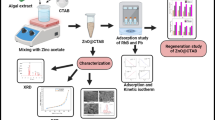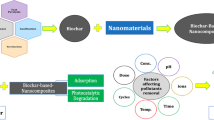Abstract
In this study, hierarchical porous polyacrylonitrile nanofibers were fabricated via electrospinning zeolitic imidazolate framework-8 (ZIF-8) and polyacrylonitrile (PAN), followed by tannic acid (TA) etching and amidoximation (denoted as p-PAN-AO). The as-prepared p-PAN-AO was utilized to remove radioactive U(VI) from sewage water and simulated seawater. The influence of uranium adsorption on p-PAN-AO was investigated as a function of uranium concentration, pH, and time. Adsorption kinetic experiments indicated that the pseudo-second-order kinetic model was fitted better than the pseudo-first-order model. Benefiting from amidoximation and hierarchical porous structure, the nanoadsorbent exhibited a high U(VI) adsorption capacity of 412.28 mg/g at 298 K. The thermodynamic analysis manifested a spontaneous and endothermic nature of U(VI) adsorption. The results demonstrated a potential application of the reported materials in nuclear wastewater and environmental cleanup.








Similar content being viewed by others
References
De Decker J, Folens K, De Clercq J et al (2017) Ship-in-a-bottle CMPO in MIL-101(Cr) for selective uranium recovery from aqueous streams through adsorption. J Hazard Mater 335:1–9
Yue Y, Mayes RT, Kim J, Fulvio PF, Sun XG, Tsouris C, Chen J, Brown S, Dai S (2013) Seawater uranium sorbents: preparation from a mesoporous copolymer initiator by atom-transfer radical polymerization. Angew Chem Int Ed 52(50):13458–13462
Davies RV, Kennedy J, Mcilroy RW et al (1964) Extraction of uranium from sea water. Nature 203(4950):1110–1115
Zhu J, Liu Q, Liu J et al (2018) Ni–Mn LDH-decorated 3D Fe-inserted and N-doped carbon framework composites for efficient uranium(VI) removal. Environ Sci-Nano 5(2):467–475
Gao J, Sun SP, Zhu WP, Chung TS (2014) Chelating polymer modified P84 nanofiltration (NF) hollow fiber membranes for high efficient heavy metal removal. Water Res 63:252–261
Chen Z, Liang Y, Jia D et al (2017) Layered silicate RUB-15 for efficient removal of UO22+ and heavy metal ions by ion-exchange. Environ Sci-Nano 4(9):1851–1858
Zhu J, Liu Q, Li Z, Liu J, Zhang H, Li R, Wang J (2018) Efficient extraction of uranium from aqueous solution using an amino-functionalized magnetic titanate nanotubes. J Hazard Mater 353:9–17
Fan FL, Qin Z, Bai J et al (2012) Rapid removal of uranium from aqueous solutions using magnetic Fe3O4@SiO2 composite particles. J Environ Radioactiv 106:40–46
Li ZJ, Wang L, Yuan LY, Xiao CL, Mei L, Zheng LR, Zhang J, Yang JH, Zhao YL, Zhu ZT, Chai ZF, Shi WQ (2015) Efficient removal of uranium from aqueous solution by zero-valent iron nanoparticle and its graphene composite. J Hazard Mater 290:26–33
Wang C, Zheng T, Luo R et al (2018) In situ growth of ZIF-8 on PAN fibrous filters for highly efficient U(VI) removal. ACS Appl Mater Inter 10(28):24164–24171
Chen H, Chen Z, Zhao G, Zhang Z, Xu C, Liu Y, Chen J, Zhuang L, Haya T, Wang X (2018) Enhanced adsorption of U(VI) and (241)Am(III) from wastewater using Ca/Al layered double hydroxide@carbon nanotube composites. J Hazard Mater 347:67–77
Saito T, Brown S, Chatterjee S et al (2014) Uranium recovery from seawater: development of fiber adsorbents prepared via atom-transfer radical polymerization. J Mater Chem A 2(35):14674–14681
Xie S, Liu X, Zhang B et al (2015) Electrospun nanofibrous adsorbents for uranium extraction from seawater. J Mater Chem A 3(6):2552–2558
Sun Q, Yang Z, Cheng H et al (2018) Creation of three-dimensional structures by direct ink writing with kaolin suspensions. J Mater Chem C 6(42):11392–11400
Zhou Z, Zhao J, Shen Y, Liu R (2017) Flash nanoprecipitation of poly(styrene-co-acrylonitrile) nanospheres and their amidoximation for uranium sorption. J Radioanal Nucl Chem 314(3):2003–2007
Bai J, Yin X, Zhu Y et al (2016) Selective uranium sorption from salt lake brines by amidoximated Saccharomyces cerevisiae. Chem Eng J 283:889–895
Horzum N, Shahwan T, Parlak O et al (2012) Synthesis of amidoximated polyacrylonitrile fibers and its application for sorption of aqueous uranyl ions under continuous flow. Chem Eng J 213:41–49
Wu M, Li C, Liu R (2019) Freestanding 1D hierarchical porous Fe-N-Doped carbon nanofibers as efficient oxygen reduction catalysts for Zn–Air batteries. Energy Technol. 7:1800790–1800798
Li C, Wu M, Liu R (2019) High-performance bifunctional oxygen electrocatalysts for zinc-air batteries over mesoporous Fe/Co-N-C nanofibers with embedding FeCo alloy nanoparticles. Appl Catal B-Environ 244:150–158
Wang T, Zhang L, Wang H et al (2013) Controllable synthesis of hierarchical porous Fe3O4 particles mediated by poly(diallyldimethylammonium chloride) and their application in arsenic removal. ACS Appl Mater Inter 5(23):12449–12459
Zhang Z, Yang Y, Li C et al (2019) Porous nanofibrous superhydrophobic membrane with embedded Au nanoparticles for the integration of oil/water separation and catalytic degradation. J Membr Sci 582:350–357
Zhang L, Gong X, Bao Y, Zhao Y, Xi M, Jiang C, Fong H (2012) Electrospun nanofibrous membranes surface-decorated with silver nanoparticles as flexible and active/sensitive substrates for surface-enhanced Raman scattering. Langmuir 28(40):14433–14440
Yue Y, Sun X, Mayes RT et al (2013) Polymer-coated nanoporous carbons for trace seawater uranium adsorption. Sci China Chem 56(11):1510–1515
Wen R, Li Y, Zhang M, Guo X, Li X, Li X, Han J, Hu S, Tan W, Ma L, Li S (2018) Graphene-synergized 2D covalent organic framework for adsorption: a mutual promotion strategy to achieve stabilization and functionalization simultaneously. J hazard mater 358:273–285
Zhao J, Qin R, Liu R (2019) Urea-bridging synthesis of nitrogen-doped carbon tube supported single metallic atoms as bifunctional oxygen electrocatalyst for zinc-air battery. Appl Catal B-Environ 256:117778
Zhao J, Fu N, Liu R (2018) Graphite-wrapped Fe core-shell nanoparticles anchored on graphene as pH-universal electrocatalyst for oxygen reduction reaction. ACS Appl Mater Inter 10(34):28509–28516
Wang H, Zhu W, Ping Y et al (2017) Controlled fabrication of functional capsules based on the synergistic interaction between polyphenols and MOFs under weak basic condition. ACS Appl Mater Inter 9(16):14258–14264
Hu M, Ju Y, Liang K et al (2016) Void engineering in metal-organic frameworks via synergistic etching and surface functionalization. Adv Funct Mater 26(32):5827–5834
Erel-Unal I, Sukhishvili SA (2008) Hydrogen-bonded multilayers of a neutral polymer and a polyphenol. Macromolecules 41(11):3962–3970
Neghlani PK, Rafizadeh M, Taromi FA (2011) Preparation of aminated-polyacrylonitrile nanofiber membranes for the adsorption of metal ions: comparison with microfibers. J hazard mater 186(1):182–189
Yao W, Wang X, Liang Y et al (2018) Synthesis of novel flower-like layered double oxides/carbon dots nanocomposites for U(VI) and 241Am(III) efficient removal: Batch and EXAFS studies. Chem Eng J 332:775–786
Sun Y, Wang X, Ai Y et al (2017) Interaction of sulfonated graphene oxide with U(VI) studied by spectroscopic analysis and theoretical calculations. Chem Eng J 310:292–299
Huang S, Pang H, Li L et al (2018) Unexpected ultrafast and high adsorption of U(VI) and Eu(III) from solution using porous Al2O3 microspheres derived from MIL-53. Chem Eng J 353:157–166
Hu L, Yan X-W, Yao C-G, Deng SY, Gao XM, Zhang XJ, Shan D (2016) Preparation of amidoximated coaxial electrospun nanofibers for uranyl uptake and their electrochemical properties. Sep Purif Technol 171:44–51
Yin L, Wang P, Wen T, Yu S, Wang X, Hayat T, Alsaedi A, Wang X (2017) Synthesis of layered titanate nanowires at low temperature and their application in efficient removal of U(VI). Environ Pollut 226:125–134
Huang Y, Keller AA (2015) EDTA functionalized magnetic nanoparticle sorbents for cadmium and lead contaminated water treatment. Water Res 80:159–168
Yang P, Liu Q, Liu J et al (2017) Interfacial growth of a metal–organic framework (UiO-66) on functionalized graphene oxide (GO) as a suitable seawater adsorbent for extraction of uranium(VI). J Mater Chem A 5(34):17933–17942
Bai ZQ, Yuan LY, Zhu L et al (2015) Introduction of amino groups into acid-resistant MOFs for enhanced U(VI) sorption. J Mater Chem A 3(2):525–534
Yuan D, Chen L, Xiong X et al (2016) Removal of uranium (VI) from aqueous solution by amidoxime functionalized superparamagnetic polymer microspheres prepared by a controlled radical polymerization in the presence of DPE. Chem Eng J 285:358–367
Xiao J, Xie S, Jing Y et al (2016) Preparation of halloysite@graphene oxide composite and its application for high-efficient decontamination of U(VI) from aqueous solution. J Mol Liq 220(C):304–310
Hosseini M, Keshtkar AR, Moosavian MA (2016) Electrospun chitosan/baker’s yeast nanofibre adsorbent: preparation, characterization and application in heavy metal adsorption. Bull Mater Sci 39(4):1091–1100
Min X, Yang W, Hui YF, Gao CY, Dang S, Sun ZM (2017) Fe3O4@ZIF-8: a magnetic nanocomposite for highly efficient UO2(2+) adsorption and selective UO2(2+)/Ln(3+) separation. Chem Commun 53(30):4199–4202
Xu C, Wang J, Yang T, Chen X, Liu X, Ding X (2015) Adsorption of uranium by amidoximated chitosan-grafted polyacrylonitrile, using response surface methodology. Carbohydr Polym 121:79–85
Keshtkar AR, Irani M, Moosavian MA (2012) Removal of uranium (VI) from aqueous solutions by adsorption using a novel electrospun PVA/TEOS/APTES hybrid nanofiber membrane: comparison with casting PVA/TEOS/APTES hybrid membrane. J Radioanal Nucl Chem 295(1):563–571
Wei X, Liu Q, Zhang H, Lu Z, Liu J, Chen R, Li R, Li Z, Liu P, Wang J (2017) Efficient removal of Uranium(VI) from simulated seawater using amidoximated polyacrylonitrile/FeOOH composites. Dalton Trans 46(45):15746–15756
Bai J, Chu J, Yin X et al (2020) Synthesis of amidoximated polyacrylonitrile nanoparticle/graphene composite hydrogel for selective uranium sorption from saline lake brine. Chem Eng J 391:123553
Funding
This study was funded by National Natural Science Foundation of China (21774095, 21976075), Fundamental Research Funds for the Central Universities (22120200051, 0400219376), Shanghai Municipal Natural Science Foundation (17ZR1432200), and China Postdoctoral Science Foundation funded project (0500229046).
Author information
Authors and Affiliations
Corresponding author
Ethics declarations
Conflict of interest
The authors declare that they have no conflict of interest.
Additional information
Publisher’s note
Springer Nature remains neutral with regard to jurisdictional claims in published maps and institutional affiliations.
Electronic supplementary material
ESM 1
(DOCX 324 kb)
Rights and permissions
About this article
Cite this article
Zhang, Z., Chu, N., Shen, Y. et al. Enhancing U(VI) adsorptive removal via amidoximed polyacrylonitrile nanofibers with hierarchical porous structure. Colloid Polym Sci 299, 25–35 (2021). https://doi.org/10.1007/s00396-020-04764-8
Received:
Revised:
Accepted:
Published:
Issue Date:
DOI: https://doi.org/10.1007/s00396-020-04764-8




